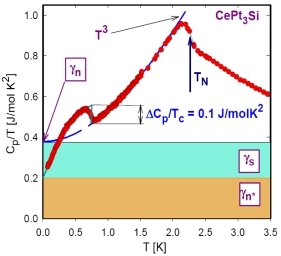Unconventional Superconductors
| A small number of ferro- or antiferromagnetically ordered heavy fermion compounds exhibit a supercondcuting instability,
if magnetic ordering is driven towards zero (compare also „Quantum critical compounds“). Superconductivity in such a scenario is, presumably,
mediated by spin fluctuations rather than by the common BCS-like electron-phonon coupling. Moreover, the Cooper pairs carrying the supercurrent
are constituted by heavy quasiparticles formed in most of the cases by a Kondo type interaction. The reduced Fermi velocity of these charge carriers
with large effective masses causes an incredibly high upper critical field in relation to the respective transition temperature. In general,
the superconducting order parameter (OP) in such materials exhibits line or point nodes, instead of the fully gapped OP in the classical BCS picture.
As a consequence, many physical properties (e.g., specific heat, thermal conductivity, ultrasonic attenuation ...) exhibit power laws instead
of exponential dependencies as it is the case for BCS superconductors.
In almost all previous studies on superconductors, it was assumed that the crystal has an inversion center, which makes it possible to separately consider the even (spin-singlet) and odd (spin-triplet) components of the superconducting OP. Recently, we have discovered a novel Ce compound (CePt3Si) which does not possess inversion symmetry in its crystal structure, but exhibits simultaneously long range magnetic order at 2.2 K and superconductivity below 0.75 K. The absence of inversion symmetry and an extraordinarily large upper critical field creates a number of constraints for the superconducting OP. Currently, the following issues are discussed with respect to CePt3Si: |
Low temperature specific heat
|
Contact: E. Bauer, H. Michor, G. Hilscher |


